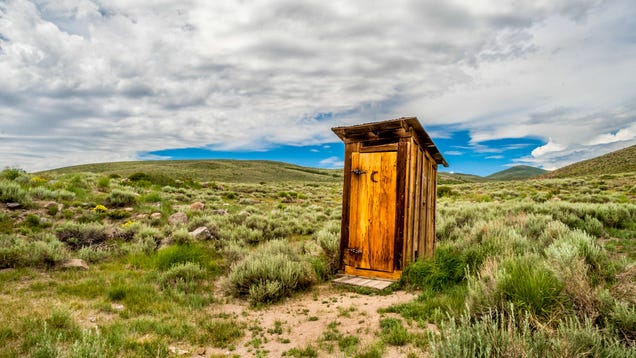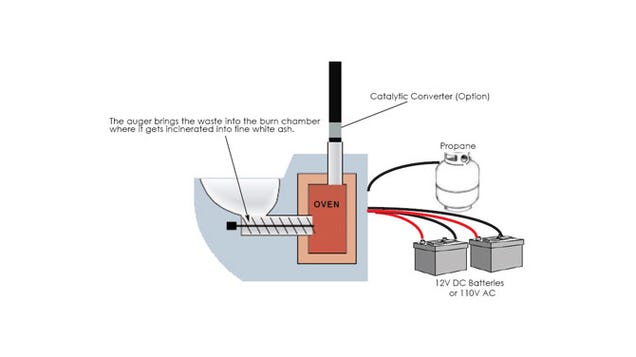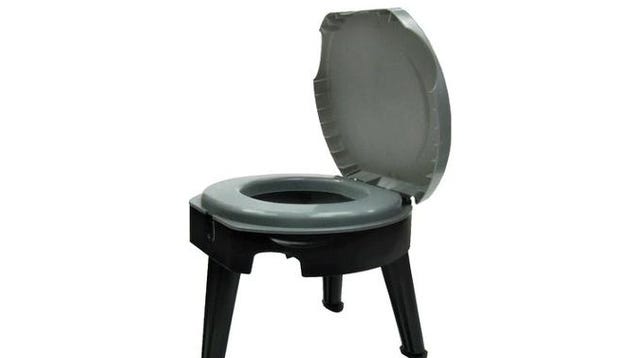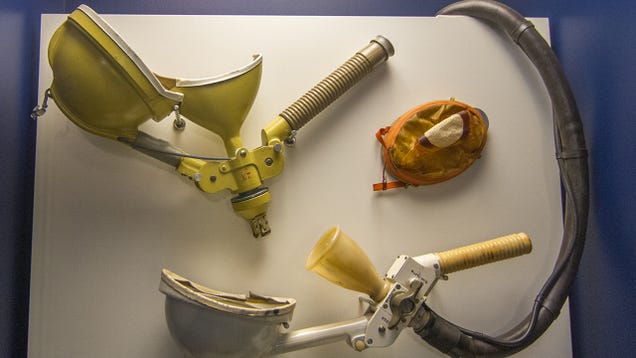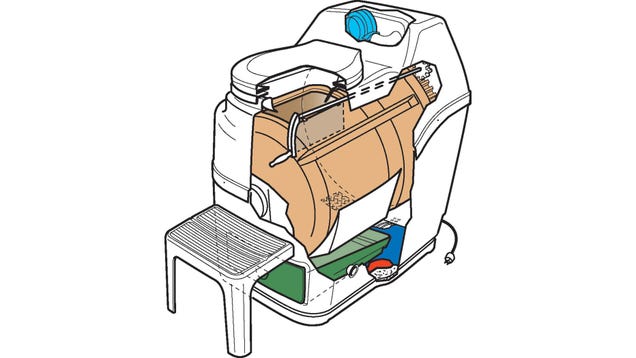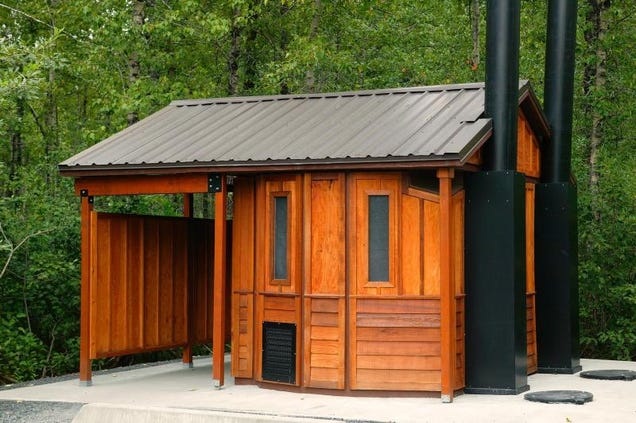There you are, visiting a remote cabin, when it’s time to poop. You walk into the bathroom and there’s a toilet seat, like normal, but underneath it is nothing but a hanging plastic bag. What do you do in it and how do you dispose of it after? Don’t worry, IndefinitelyWild is here to help you poop properly.
Incinerating Toilet
Where You’ll Find It: Waste difficult to dispose of? Incinerating toilets only produce about a tablespoon of ash per normal human bowel movement, and they require no water to operate. So, you’ll find them in remote arctic research stations, tiny cabins, onboard boats and anywhere else that needs to prioritize ease of waste management over cost.
What It Does With Your Poop: Burns it! The benefit here is that the ash is both sterile and odor free. Plus, theres very little of it. So, it’s easily dumped, buried or scattered. And, burning your poop doesn’t eliminate the nutrients contained therein, so the ash makes a great soil amendment on the farm or around the garden.
The trouble is, incinerating toilets require power. Most use electricity, meaning they can only be installed in applications that are connected to the power grid, use an alternative form of generation (like solar) or at least have a bank of car batteries hooked up. There are some types that operate on propane, diesel or even natural gas, for applications that already have those fuel sources hooked up. Solar heat can even be used in some, specific units.
All that makes these toilets relatively expensive. Popular Incinolet electric toilets start around $2,300 for a unit capable of handling the poop of four humans. They obviously also require transportation of the bulky, heavy toilet to wherever you want it, as well as installation. So you’ve got to be pretty serious about low-waste poop disposal to want one.
How You Poop In It: The key here is to make sure you properly place a bowl liner (typically a paper cone) in the toilet bowl before each use. You poop and pee in that, then close the lid and operate a pedal or lever that drops the liner full of poo into the incinerator. There’s typically a safety mechanism that prevents the incinerator from firing while the lid is open, but it’s still a good idea to identify the firing button ahead of time and to avoid pushing it while your butt is hovering over the bowl. Once you’ve dropped the liner into the incinerator and ensured the lid is closed, you push that button and your poop and pee are burned right up. Thanks to an outside vent and very hot temperatures, there shouldn’t be any odor or smoke. The ash falls into a removable waste pan which will need to be emptied once every few uses, depending on its volume.
I feel like I should explain the need for the liner: It allows your nasty poop to collect in it and not on the bowl. So, when you release it to to fall into the incinerator, there’s no skidmarks. Use the liner.
Bag Toilet
Where You’ll Find It: The ultimate in impromptu human waste catching, plastic bag toilets are extremely portable, very cheap and last as long as you have plastic bags to fill with poop. So, they’re great for car camping, boaters on a budget, disaster relief and even for use in your own home, in an emergency.
What It Does With Your Poop: Catches it in a bag that you can then dispose of in the trash. In emergencies or post-disaster, when concerns about environmental damage are trumped by the need to eliminate potential pathogen vectors, you can also burn or bury the poo-filled bags.
How You Poop In It: Well, that depends on the form of toilet being used.
Dedicated plastic bag toilet seats exist that capture the edges of the bag under the seat. The key with them is to make sure the bag is adequately retained around its entire perimeter.
You can make an easy plastic bag toilet using a 5-gallon bucket and a tight fitting lid. Just wrap the bag around the top of the bucket and tie it off on the outside so it stays up.
While outdoors in a remote, sensitive environment, you can just go directly in the bag (carefully!) or just use it to scoop your poop like you do with your dog’s.
With that last option, you tie off the bag after each and every use, then pack it out either in another bag or in a section of capped PVC tube. More details in our previous article,
How To Poop In the Woods.
With the toilet seat or bucket, you may want to make the bag last across multiple uses. Make sure you close the lid to minimize odor and the spread of disease. Adding lime or kitty litter to the bottom of the bag, then putting a little scoop over each go can help with this as well. Then you simply remove the bag when it’s “full” and tie it off.
Zero Gravity Toilet
Where You’ll Find It: Visiting the International Space Station? Then prepare yourself to use a zero-G toilet. Other forms of space travel, including Virgin Galactic, don’t include toilet facilities. Hope you’re good at holding it!
What It Does With Your Poop: The short version is that liquid waste is vented to space while solid waste is dried, compacted and returned to earth. One less thing to potentially run into in orbit.
How You Poop In It: While it might seem practical to employ the natural vacuum of space, poking holes in the space station is generally frowned upon. Instead, a powerful fan sucks air down a tube. To pee in this tube, men and women select the appropriate funnel and urinate into it. A suctioned connection is not required; you “hover” within an inch or two.
To poop, they hold a special baggie under their bums that won’t let solids pass through, but does allow air to pass through. So, the same fan sucks the poop into the bag and holds it there. The astronaut (or rich visitor) then ties the bag off and inserts it into a waste collection drawer where it’s compressed. Since the Space Station is a closed environment, the air that fan sucks through is filtered to remove odor and bacteria, then circulated back into the living environment. And you thought the flying fart cans that are commercial airliners were bad.
Composting Toilet
Where You’ll Find It: An affordable alternative to the combustion toilet, these also turn your poop into something less gross and more useable without water or a septic tank. So, you’ll also find them in remote cabins and similar environments. These differ from pit toilets (which you’ll find in most outhouses) in that they keep the human waste separate from groundwater, keeping the local environment safe from pathogens.
What It Does With Your Poop: You’re basically just pooping into a deep pit or enclosed container in which environmental conditions are optimized to encourage microbe reproduction. These “eat” your poop, removing pathogens and breaking it down into a useable, organic fertilizer.
Left at its natural pace, this process is slow and only able to deal with a limited quantity of poo. So, to make composting toilets more suitable to regular, high-volume use, apply heat, active venting (fans) and other techniques to encourage the breakdown.
The result should be a dry, odorless material that should look, feel and smell like the compost you produce in your garden. You then dispose of the compost by scattering it outdoors, or use it to fertilize your farm or garden.
Some composting toilets may additionally facilitate the process by diverting urine, keeping the waste as dry as possible.
How You Poop In It: In most, you do your business, then add a scoop of peat moss, sawdust or ground coconut husk that absorbs some moisture and cuts down on odor. You’ll typically find this adjacent to the toilet. As with pit toilets, it’s key that you use only biodegradable toilet paper and put no other foreign matter into the toilet. You really, really, really need to close the lid, too. This prevents odors from invade the bathroom, instead allowing them to flow out through the vent pipe that rises above the roof, where they can be spread out by the wind.
Vault Toilet
Where You’ll Find It: At National and State Parks, campgrounds and similarly high-use outdoor recreation places. You’ll spot them because they’re permanent structures that don’t have electricity or water hooked up, but do have prominent vent pipes protruding from their roofs.
What It Does With Your Poop: Your poop falls down into an underground chamber that’s typically 750 to 13,000 gallons in size. And there it sits until a truck comes and pumps it out, then transports it to a municipal water treatment facility.
How You Poop In It: These toilets are far from weird, but I’m including them here simply to perform a public service. Please, please, please close the lid when you’re done. These toilets are designed to manage odor by allowing it to flow out the vent pipe. If you don’t close the lid, the odor simply permeates the bathroom space, making it absolutely terrible to use. If everyone does close the lid, they remain pleasant places to take a poop. Same concept in a Port-A-John.
Have you used (or failed to use) any other weird toilets outdoors? Tell us about them.
source: http://indefinitelywild.gizmodo.com/how-to-use-all-the-weird-toilets-you-ll-find-outdoors-1714620265
by Wes Siler
http://www.thisoldtoilet.com














